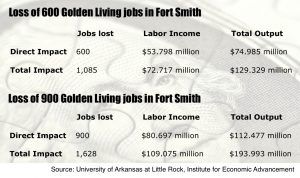Report: Golden Living center in Fort Smith helps sustain more than 1,600 jobs, $194 million in state GDP
by September 12, 2016 1:48 pm 479 views

Fort Smith metro business expansions are helping the regional economy finally gain traction in terms of job gains after more than seven years of post-Great Recession declines. But revelations about changes at Golden Living’s Fort Smith admin center could slow what has been a struggle to return to pre-recession job numbers.
Talk Business & Politics recently reported that Golden Living is in the process of selling three of its service companies and possibly scaling back to operating only around one-third of the nursing homes it now manages. Golden Living is based in Dallas, with the former corporate headquarters in Fort Smith now serving as the company’s administrative center. The Fort Smith facility employs around 900, according to Michelle Metzger, Golden Living director of communications. Overall, Golden Living employs just under 40,000.
New information from sources suggest that Golden Living has sold or leased around 140 of its more than 300 nursing home facilities.
When asked again for comment about what the known and possible changes in Golden Living operations would mean for the admin center, Metzger responded: “We continually evaluate our business strategy and have no plans to close the Fort Smith office.”
POTENTIAL ECONOMIC SETBACK
Several sources have told Talk Business that employment at Golden Living’s Fort Smith admin center could fall to just a few hundred or those remaining to provide support for the businesses that remain would be moved to north Dallas where Golden Living management is based.
The thought of losing such good jobs and having so much Class A office space sitting empty is certainly unsettling. The potential losses would also put the brakes on recent economic growth trends for the Fort Smith metro.
Fort Smith’s metro jobless rate was 5% in July, unchanged from June, but lower than the 5.7% in July 2015. The size of the Fort Smith regional workforce during July was 123,059, up from 122,835 during June, and just above the 122,642 in July 2015. The labor force reached a revised high of 132,004 in July 2007, meaning the July workforce size is down 6.77% from the peak number, according to figures from the U.S. Bureau of Labor Statistics (BLS).
The number of employed in the Fort Smith region totaled 116,962 in July, up slightly from the 116,729 in June, and up 1.15% from the 115,621 employed in July 2015. However, the number of employed in the area is down 6.7% compared to the high of 125,426 in July 2006.
Unemployed persons in the region totaled an estimated 6,097 during July, down from the 6,106 during June, and below the 7,021 during July 2015. The Fort Smith and Pine Bluff metro areas are the only two in Arkansas that have not returned to the pre-recession number of employed.
Annual average employment in the Fort Smith metro set a record of 123,254 in 2007, the year before the Great Recession hit the area. The average would fall to 115,923 by 2010. In 2012, the year Whirlpool closed its Fort Smith manufacturing plant, the average fell to 113,965, and would hit an annual average low of 111,399 in 2013.
Fortunately, there was a bottom. Average annual employment grew to 114,528 in 2015, with employment rising to 116,962 in July 2016.
ESTIMATED JOB LOSSES
Talk Business & Politics asked Dr. Greg Hamilton, with the Institute for Economic Advancement at the University of Little Rock, to estimate the impact of losing 600 of the 900 Golden Living jobs, and the impact of losing all the jobs.

The loss of 600 of the 900 jobs at Golden Living would result in a loss of 1,047 jobs in the Fort Smith metro and a total loss of 1,085 jobs for the state – meaning that 38 jobs would be lost outside of the Fort Smith metro if the company cut 600 jobs in Fort Smith.
Annual labor income lost in the Fort Smith metro area would be an estimated $70.895 million, with a total output labor income loss of $123.869 million.
While that sounds like a big loss, the labor income hit is an estimated 1.42% loss for the Fort Smith metro. But again, for a regional economy struggling to gain ground, that percentage loss is not helpful.
Losing all 900 jobs would also not be helpful. Hamilton’s report estimates the total loss of 1,571 regional jobs if Golden Living were to close its Fort Smith admin center. The regional labor income loss could total $106.343 million, with total output labor income losses reaching $185.803 million. The loss of the 900 Fort Smith jobs would also result in just under 57 jobs lost in Arkansas outside the Fort Smith metro.
The overall impact of losing 900 Golden Living jobs could result in a state GDP loss of $193.993 million.
The labor income loss, while staggering when considering the number, is a 1.91% hit to the regional economy. But again, that loss could be hard to absorb for a regional economy that has yet to recover from the Great Recession.
